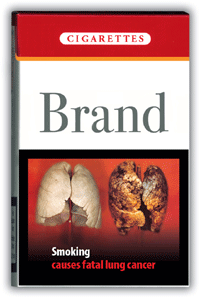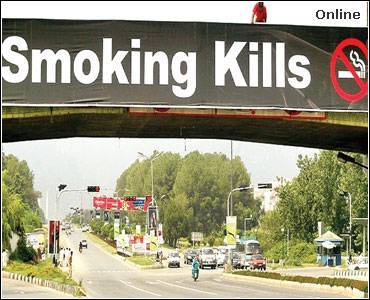 November 25, 2009 - Frightening figures: about a 100,000 people die in Pakistan annually owing to diseases related to smoking. Pakistan has finally decided to stub it out, so to speak. Beginning next February, cigarette packs will have pictorial warnings to wean smokers away from, well, ending up in a smoke.
November 25, 2009 - Frightening figures: about a 100,000 people die in Pakistan annually owing to diseases related to smoking. Pakistan has finally decided to stub it out, so to speak. Beginning next February, cigarette packs will have pictorial warnings to wean smokers away from, well, ending up in a smoke.
Until now, any official attempt to check the menace was limited to observing the annual World No-Tobacco Day with sound and the odd fury but little action.
Pakistan’s Ministry of Health has now mandated that cigarette packs will have picture-based health warnings that cover 40% of the principal display area on both the front and back of the packs. The decision has been hard-fought and hard-earned on the part of those campaigning for control given the clout of the tobacco industry, which still managed to pressurise the ministry into reducing the original recommended size of half the display area to forty per cent.
The decision to make graphic health warnings mandatory was announced at a seminar arranged in connection with World No Tobacco Day on May 31 this year. At the time, the ministry had announced January 1, 2010 as the deadline for the implementation of the decision. The intervening period was marked by hectic lobbying by the tobacco industry, which tried everything it possibly could to delay the move for pictorial warnings.
While the inevitable has been delayed by only a month, the tobacco industry successfully lobbied to have the size of pictorial warning reduced by a fifth. Its lobbyists argued that even in Britain, a lead time of three years was given to the industry. However, Pakistan’s ministry of health appears to have weathered the storm from different quarters and has largely lived up to the expectations of those campaigning for control over the grave threat it poses to millions in Pakistan.
The industry also reportedly, argued that it did not have state-of-the-art printing machines required for four-colour printing on cigarette packs. Some bureaucrats working for an Islamabad-based tobacco company worked their butts off (no pun intended) to first buy time till the end of 2020 and then at least till mid next year.
Islamabad has already withdrawn the controversial Statutory Regulatory Order on designated smoking areas and even closed the smoking lounges at the parliament — a symbolic step given the significance of where the first step was taken.
It is heartening for health-conscious Pakistanis to know that President Asif Zardari has taken personal interest to get the whip cracking. To begin with, he has stopped the purchase of special cigarettes for the Presidency.
The Pakistan Tobacco Company was until now manufacturing cigarettes with insignias of the Presidency, Prime Minister House and Governor Houses on cigarette packs - an obvious reflection of their reach and clout.
The government has taken up recommendations for high resolution images that arouse fear and shock along with health warnings on cigarette packs and extend the same to other smokeless tobacco products. The selected photos would target current smokers in order to encourage them to give up smoking, the youth to save them falling into a potentially killing habit and to drive home the dire message among non-smokers tempted to join the league.
These measures were perhaps necessary given few were willing to walk the talk. In Pakistan, the media is particularly to blame for underplaying messages aimed at highlighting the extremely harmful effects of smoking.
Perhaps, the reason lies in the majority of journalists themselves being smokers — some chain, others occasional and the rest puffing their way just to be seen in the same “macho” league.
Is it any wonder therefore, that according to a study no more than 5% of the Pakistani population is aware that tobacco smoking damages the lining of blood vessels, deposits cholesterol and reduces the blood flow to the heart causing heart diseases? But this is nothing compared to statistics that should have the smoke coming out of most ears. The situation begs urgent attention — before the current generation of smokers and those following it end up in a smoke themselves.
Early bird catches the worm, they say, and so should be the emphasis on getting a handle on youth in particular, which at 42% of Pakistan’s population, are the most vulnerable to the menace.
Consider these facts:
-According to Ministry of Youth Affairs, every day, 1,200 young Pakistanis — aged between six and 15 - including girls begin smoking. Independent experts put the daily figure at 1,600 between the ages of 15 and 19.
-There are about 30mn smokers in Pakistan, 28% of these are students. Schools, colleges and universities serve as breeding grounds — away from any prying eye — for these students.
-According to a recent research by the National Health Services of Pakistan, 14.4bn cigarettes are sold daily — a million every minute.
-Pakistan Medical Society says 42.7% of the country’s population indulge in tobacco smoking on a daily basis.
-According to Pakistan Institute of Medical Sciences, 40% of the patients admitted in the Intensive Care Unit of Islamabad’s top medical facility with lung disease are smokers.
Around 75% of the patients visiting the cardiology outpatient department suffer from ischemic heart disease and 70% of these are chronic smokers between the ages of 40 to 55. Not surprisingly, most of them began smoking when they were young.
-According to Pakistan Anti-Smoking Society, tobacco sales per year in Pakistan amount to 108,000 tonnes. The government gets an annual revenue of $452mn out of these sales.
-About a 100,000 people die in Pakistan every year owing to diseases related to tobacco smoking.
It is not for want of regulations but the spirit and willingness to implement those regulations that has allowed the tobacco industry a free reign. The World Health Organisation says if Islamabad is really serious, it should ban all forms of tobacco advertising and substantially, raise the taxation system.
The new measure will at least provide hope to those who wondered if Pakistan, which ranks with India, Japan, Thailand and Turkey as one of the world’s largest tobacco growers and where the government benefits enormously from its sale will be able to stop young people from dying for a smoke — perhaps, literally.
Reference: Hope in a land dying for smoke by Kamran Rehmat (kaamyabi@gmail.com)/Islamabad, Gulf Times, 11/18/2009.
Pakistan - related news brief:
Pakistan - National Conference on Tobacco Control, October 28th..;
Pakistan - pictorial health warnings on cigarette packs and cartons soon..;
Pakistan - More, on rollback of the Statutory Regulatory Order on Designated Smoking Areas..;
Smuggled Cigarettes Give Boost To Pakistani Militants..;
Pakistan - strong tobacco control measures..;
Pakistan - Government must withdraw Statutory Regulatory Order..;
Bloomberg Grant: Tobacco Reforms in Pakistan...
Bringing the World of Tobacco Control closer together..
Pakistan - February, 2010 - graphic warnings on cigarette packs..
Subscribe to:
Post Comments (Atom)


To Provide Public Awareness
Purpose
About Us
Contact Us
2008 HIGHLIGHTS
TOPIX PAPERS - 2008 & 2009..
Archive
-
▼
2009 (1446)
-
▼
11/22 - 11/29 (28)
- Cigarette smokers are at significant risk for seiz...
- Virginia - December 1, 2009 smoking ban goes into ...
- Cigarette smoke death of the transplanted heart..
- Fitch Ratings - review of events that could advers...
- Malaysia - stepping up efforts to curb the trade i...
- Bulgaria - MPs Impose Hefty Fines on Cigarette Sa...
- Malaysia - BAT plans to dispose of a parcel of ind...
- In Process: Lorillard summary - Morgan Stanley's...
- Ireland - after 2004 smoking ban decline in matern...
- Mechanism - how environmental irritants like cigar...
- New Jersey - legislation proposed to prohibit sale...
- Australia, New South Wales - BAT pushes for remov...
- United Kingdom - public smoking ban does not lead ...
- More: Philip Morris - Ruyan Group - e-cigarettes..
- Pakistan - February, 2010 - graphic warnings on ci...
- Florida - targeting companies that did not particp...
- Ghana - public forum on the tobacco control bill..
- Japan - prime minister calls for tobacco tax incre...
- Star Scientific - NASDAQ trading symbol changed to...
- Conwood maker of Grizzly to change name to Americ...
- Bulgartabac Chief - cigarette tax increase as of ...
- Philip Morris USA - will no longer purchase tobacc...
- Alberta joins some other provinces in suing toba...
- Reynolds American to sell historic former headquar...
- South Dakota - smoking ban one more possible appeal..
- Turkey - graphic/written warning labels starting J...
- Lorillard - president and CEO Orlowsky to be repl...
- Bulgaria Bulgartabac Holding Sells 23% of Shares t...
-
▼
11/22 - 11/29 (28)
© Copyright Notice: The content of this website is for information education purposes only and any newsbrief may be used only as "fair use" for information/education purposes with permission of the authors and providing that original references and associated reference links are included in HTML format.
0 comments:
Post a Comment